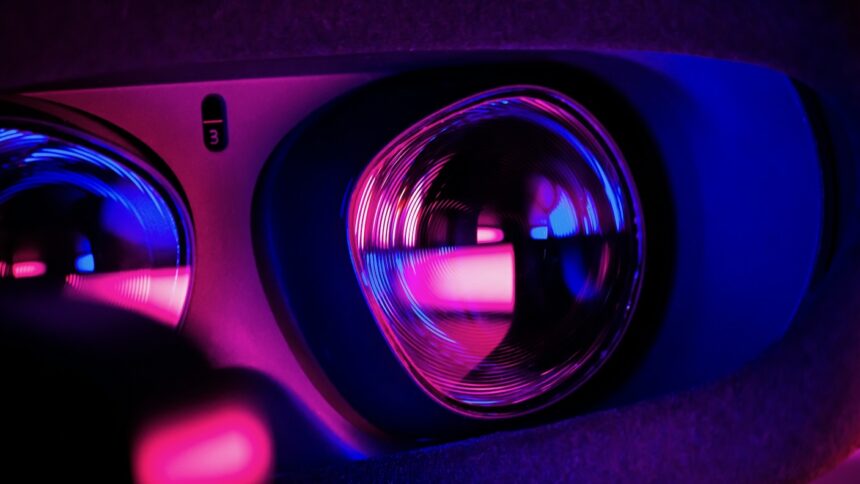Back in 2017, my editor published an article titled “The Next Great Computer Interface Is Emerging—But It Doesn’t Have a Name Yet.” Seven years later, which may as well be a hundred in technology years, that headline hasn’t aged a day.
Last week, UploadVR broke the news that Apple won’t allow developers for their upcoming Vision Pro headset to refer to applications as VR, AR, MR, or XR. For the past decade, the industry has variously used terms like virtual reality (VR), augmented reality (AR), mixed reality (MR), and extended reality (XR) to describe technologies that include things like VR headsets. Apple, however, is making it clear that developers should refer to their apps as “spatial” or use the term “spatial computing.” They’re also asking developers not to refer to the device as a headset (whoops). Apple calls it a “spatial computer,” and VR mode is simply “fully immersive.”
It remains to be seen whether Apple will strictly enforce these rules, but the news sparked a colorful range of reactions from industry insiders. Some amusingly questioned what an app like VRChat, one of the most popular platforms in the industry with millions of monthly active users, should do. Others debated at the intersection of philosophy of language and branding to explore Apple’s broader marketing strategy.
Those who have worked in this area are certainly aware of the longstanding absurdity of relying on an inconsistent patchwork of terms.
— Hrafn Thorisson (@hrafntho) September 27, 2021
While no one company has successfully forced linguistic consensus yet, this is certainly not the first time a company has set out to define this category in the minds of consumers.
In 2017, as Google first started selling VR devices, they attempted to steer the industry toward the term “immersive computing.” Around the same time Microsoft took aim at branding supremacy by fixating on the label “mixed reality.” And everyone will remember that Facebook changed the company’s name in an effort to define the broader industry as “the metaverse.”
The term spatial computing is certainly not an Apple invention. It’s thought to have been first introduced in the modern sense by MIT’s Simon Greenwold in his 2003 thesis paper, and has been in use for much of the past decade. Like many others, I’ve long found the term to be the most useful at capturing the main contribution of these technologies—that they make use of three-dimensional space to develop interfaces that are more intuitive for our nervous systems.
A winding etymological journey for a technology is also not unique to computer interfaces. All new technologies cycle through ever-evolving labels that often start by relating them to familiar concepts. The word “movie” began life as “moving picture” to describe how a collection of still images seemed to “move,” like flipping through a picture book. In the early 1900s, the shorter slang term movie appeared in comic strips and quickly caught on with the public. Before the term “computer” referred to machines, it described a person whose job was to perform mathematical calculations. And the first automobiles were introduced to the public as “horseless carriages,” which should remind us of today’s use of the term “driverless car.”
Scholars of neuroscience, linguistics, and psychology will be especially familiar with the ways in which language—and the use of words—can impact how we relate to the world. When a person hears a word, a rich network of interconnected ideas, images, and associations is activated in our mind. In that sense, words can be thought of as bundles of concepts and a shortcut to making sense of the world.
The challenge with labeling emerging technologies is they can be so new to our experience, our brains haven’t yet constructed a fixed set of bundled concepts to relate to.
The word “car,” for example, brings to mind attributes like “four wheels,” “steering wheel,” and “machine used to move people around.” Over time, bundles of associations like these become rooted in the mind as permanent networks of relationships which can help us quickly process our environment. But this can also create limitations and risk overlooking disruptions due to an environment which has changed. Referring to autonomous driving technology as “driverless cars” might result in someone overlooking a “driverless car” small enough to carry packages on a sidewalk. It’s the same technology, but not one most people might refer to as a car.
This might sound like useless contemplation on the role of semantics, but the words we use have real implications on the business of emerging technologies. In 1980, AT&T hired the consultancy McKinsey to predict how many people would be using mobile phones by the year 2000. Their analysis estimated no more than 900,000 devices by the turn of the century, and because of the advice, AT&T exited the hardware business. Twenty years later, they recognized how unhelpful that advice had been as 900,000 phones were being sold every three days in North America alone.
While in no way defending their work, I hold the opinion that in some ways McKinsey wasn’t wrong. Both AT&T and McKinsey may have been misled by the bundle of concepts the word “mobile phone” would have elicited in the year 1980. At that time, devices were large, as heavy as ten pounds or more, cost thousands of dollars, and had a painfully short battery life. There certainly wasn’t a large market for those phones. A better project for AT&T and McKinsey might have been to explore what the term “mobile phone” would even refer to in 20 years. Those devices were practical, compact, and affordable.
A more recent example might be the term “metaverse.” A business operations person focused on digital twins has a very different bundle of associations in their mind when hearing the word metaverse than a marketing person focused on brand activations in virtual worlds like Roblox. I’ve worked with plenty of confused senior leaders who have been pitched very different kinds of projects carrying the label “metaverse,” leading to uncertainty about what the term really means.
As for our as-of-yet-unnamed 3D computing interfaces, it’s still unclear what label will conquer the minds of mainstream consumers. During an interview with Matt Miesnieks, a serial entrepreneur and VC, about his company 6D.ai—which was later sold to Niantic—I asked what we might end up calling this stuff. Six years after that discussion, I’m reminded of his response.
“Probably whatever Apple decides to call it.”
Image Credit: James Yarema / Unsplash




